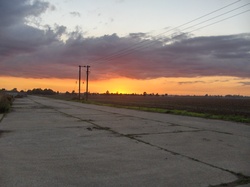Immediately after the war, due to an acute shortage, the accommodation sites at Fiskerton were used as temporary housing up until 1954,
The four sites on the Bardney road were called: The Cresent; Ferryside; Woodlands & Longwood.
The four on the accommodation access road were named: Hallfields; Fenlands; Moorlands & Birchill.
The Sergents'mess on Site 3 was used as the village school up until 1970.
Today, the airfield is used for a variety of purposes. Arable and poultry farming on the main site.
Oil was discovered under the airfield in 1977.
Production with two pumps began a year later. These are situated next to the south-eastern peri-track at the end of the old Technical site.
All the buildings have been demolished on the main site including the tower complex and hanger.
A narrow section of the main runway remains
and is used for access to the poultry farm.
Some sections of the subsiduary runways are still intact and are still the original width but other sections
have been removed to prevent joy-riding/racing.
Some of the original landing light holders still litter the runway.
Large sections of peri-track are still there and are used for access to the oilfield.
A couple of dispersal points are still there in the old 'A' flight area.
The disused Royal Observer Corp H/Q is located in the old 'A' flight area.
Part of the old ops block still stands and is used for stabling.
West of the road little remains save for a narrow section of runway, a section of peri-track and a dispersal point.
Of the side of the airfield west of the road,a narrow section of runway remains.
Some section of peri-track and a dispersal and the petrol stores.
The airfield is popular with walkers, cyclists, runners and dog exercisers and several public footpaths cross the airfield.
One of these footpaths follows the peri-track adjacent to the old Technical site and walking down the track at twilight
on a peaceful summer's evening it is hard to imagine the activity that would have been taking place all those years ago during W.W.2.
Of the dispersed sites, the gymnasium,building 206 on site 4 is visible from the road.
On site 9 the base of the sick bay,building 328 is still there and is used for storing straw bales.
Site 3 is privately owned and several buildings have survived the years.
These are used by small businesses and personel use by the site owner.
Among them are the officers'mess and the Sergeants' messes, a power house and several other buildings
which have been preserved and utilised by the gentleman owner who very kindly allowed me to photograph the site and
showed me around.
The site is very pleasent with landscaped areas and an orchard.
Over the years many former occupants of the site have been back to re-visit
and the owner has a visitors' book for them to sign. Another part of site 3, building number 178 is occupied by the Tanya Wool factory.
Of the other dispersed sites, small copices mark the locations and nothing remains save for a few buildings and some concrete bases
of what would have been a hive of activity all those years ago.
In total, the airfield had, during its operational life, over 400 buildings including 275 on the dispersed sites.
Ranging from hangers to living quarters, briefing rooms to dininghalls and messes.
Now, only a handful remain of what would have been a self-contained community and was home to over 2,000 persons.
Inevitably, empty buildings attract unwarranted attention or become dangerous to enter.
It therefore was necessary to demolished them for these reasons.
UPDATE TO ABOVE: October 2006, the Lincolnshire Echo has announced that the Tanya Wool factory which has
occupied the former Dining Hall on site 3,building No. 178 is in financial difficulties and may be forced to close.
2009: Factory finally closed but is still standing.
This dining hall was where aircrew had their pre-flight meal and is so many cases was their final one.
October 2010. Plans submitted for the building of a compost-making facility which were rejected.

